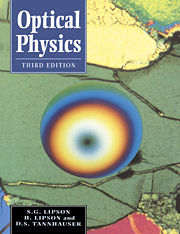Book contents
- Frontmatter
- Contents
- Preface to the third edition
- Preface to the second edition
- Preface to the first edition
- 1 History of ideas
- 2 Waves
- 3 Geometrical optics
- 4 Fourier theory
- 5 Electromagnetic waves
- 6 Polarization and anisotropic media
- 7 Diffraction
- 8 Fraunhofer diffraction and interference
- 9 Interferometry
- 10 Optical waveguides and modulated media
- 11 Coherence
- 12 Image formation
- 13 The classical theory of dispersion
- 14 Quantum optics and lasers
- 15 Problems
- Appendix 1 Bessel functions in wave optics
- Appendix 2 Lecture demonstrations in Fourier optics
- Bibliography
- Index
1 - History of ideas
- Frontmatter
- Contents
- Preface to the third edition
- Preface to the second edition
- Preface to the first edition
- 1 History of ideas
- 2 Waves
- 3 Geometrical optics
- 4 Fourier theory
- 5 Electromagnetic waves
- 6 Polarization and anisotropic media
- 7 Diffraction
- 8 Fraunhofer diffraction and interference
- 9 Interferometry
- 10 Optical waveguides and modulated media
- 11 Coherence
- 12 Image formation
- 13 The classical theory of dispersion
- 14 Quantum optics and lasers
- 15 Problems
- Appendix 1 Bessel functions in wave optics
- Appendix 2 Lecture demonstrations in Fourier optics
- Bibliography
- Index
Summary
Importance of history
Why should a textbook on physics begin with history? Why not start with what is known now and refrain from all the distractions of out-of-date material? These questions would be justifiable if physics were a complete and finished subject; only the final state would then matter and the process of arrival at this state would be irrelevant. But physics is not such a subject, and optics in particular is very much alive and constantly changing. It is important for the student to understand the past as a guide to the future. To study only the present is equivalent to trying to draw a graph with only one point.
It can also be interesting and sometimes sobering to learn how some of the greatest ideas came about. By studying the past we can sometimes gain some insight – however slight – into the minds and methods of the great physicists. No textbook can, of course, reconstruct completely the workings of these minds, but even to glimpse some of the difficulties that they overcame is worthwhile. What seemed great problems to them may seem trivial to us merely because we now have generations of experience to guide us; or, more likely, we have hidden them by cloaking them with words. For example, to the end of his life Newton found the idea of ‘action at a distance’ repugnant in spite of the great use that he made of it; we now accept it as natural, but have we come any nearer than Newton to understanding it?
- Type
- Chapter
- Information
- Optical Physics , pp. 1 - 14Publisher: Cambridge University PressPrint publication year: 1995



